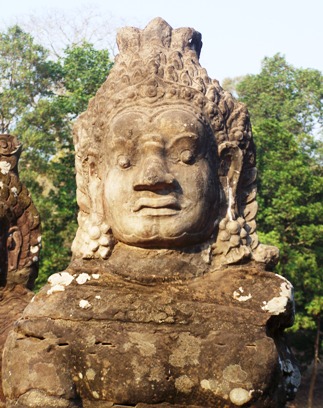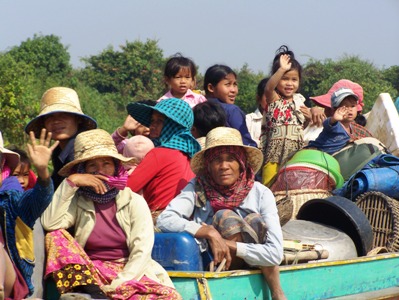Within the dense jungles of northwestern Cambodia
is the ancient city of Angkor, once the capital of the Khmer Kingdom which
dominated much of Southeast Asia from AD 802 to 1432. It is thought that 750,000 people lived in
Angkor, making it the most extensive urban complex in the pre-industrial world.
Located in this 77-square-mile area
there are at least 70 temples and other structures. One of those is Angkor Wat ("Capital Temple" in the Khmer language), the largest single religious complex in the
world! There is also the mystical Ta Prohm site shrouded in silk cotton
trees, banyan trees and creeping fig trees. The delicate bas-relief of Banteay
Srei has lead it to be referred to as the Citadel of Women. This temple was founded by priests, not by a
royal family as the other temples were. Due
to political discord these magnificent edifices were not accessible to archeologists
or tourists for decades, but it is once again possible to visit this amazing
place. In 2011 Mike and I had the opportunity
to view and walk within the walls of some of the most awe-inspiring sites
created by man.
 |
Built AD 1080-1175 by King Suryavarman II, Angkor Wat represents the mythical
abode of the gods and the center of the universe |
 |
Hindu Priests praying near the entrance to Angkor Wat Temple.
Angkor Wat is a holy shrine in both the Hindu and Buddhist religions |
 |
A wedding party in front of the temple gives one a perspective of just how large the temple is.
The entire temple is surrounded by a moat, representing the outer edge of the universe. |
 |
Apsaras, celestial dancing girls, are a go-between between man and the gods.
At Angkor Wat, there are over 2,000 engravings similar to these.
One bas-relief panel measures 1,970 feet in length. |
 |
A view of the temple courtyard looking down from one of the towers,
gives some perspective on how vast the complex is. |
 |
These temples were "lost" for centuries, swallowed up by the encroaching jungle,
They became known to the rest of the world when the French uncovered them
around the early 1940's and began restoring them. |
 |
Ta Prohm was once a Buddhist Monastery, with 18 "High Priests"
and 12,640 temple "workers". Note how the Kapok (silk cotton)
trees have grown around and into the building. |
 |
Angkor Thom Temple: Rows of gods lining the path to the temple's south gate.
154 statues, gods on the left (shown) and demons on the right (not shown) |
 |
Angkor Thom's central towers each have four smiling faces gazing
out in the cardinal directions. This temple was built by King
Jayavarman VII in the late 12th century |
 |
| King Jayavarman VII |
 |
Entrance to Banteay Srie, called the Citadel of Women, because of its
delicate carvings. It is located 19 miles from Angkor Wat. |
 |
Inside Banteay Srie, the Monkey King, Hanuman, a Hindu god, guards the building.
This temple was founded in the second half of the 10th century by Hindu Priests |
 |
| Another view of the Monkey Kings guarding the temple |
 |
It is amazing that so much of the bas-relief has survived, but this man's
wife (or mistress) has lost her head. |
 |
Phnom Bakheng Temple, ca. 889-910 AD. Kings and priests gathered at this spot.
Now tourists gather here because the setting sun brightly illuminates the towers of
Angkor Wat. There is concern about damage to this temple from all the people. |
The amazing sites (and sights) of Angkor capture
the visitor's imagination but, of course, the people of Cambodia are the real
story. Even though extremely brief, I
feel it would be remiss not to touch on the history of Cambodia. The people of Cambodia reflect the strength
and resiliency of the human spirit.
 |
| We took an ox cart tour of this village, on a tributary of the Siem Reap River |
 |
The ox cart driver invited us to his home to meet his family. They spoke very
little English, but we still managed to communicate with them. |
Cambodia has been fraught with conflict since its inception. Its history can be traced back to the 6th century. By AD 800 under Jayavarman II, the great Khmer temples were built. After several centuries of wars, a period of relative peace permitted the building of the elaborate capital, Angkor Thom.
Then came an extended period of foreign
influence. The Spanish invaded in 1596
but were soon defeated by the Siamese. During
the following centuries there was almost always combat with Thailand and
Vietnam. In 1863 the French sent
gunboats into the area to create a French Protectorate. In 1941 the Japanese took power and held Cambodia
until the end of the war, when the country was returned to the French. In 1953 King Sihanouk rose to power and
established The Peoples Communist Party.
Cambodia remained neutral in the Vietnam
War until 1965, when the Viet Cong were allowed to use Cambodian territory,
leading to extensive bombing by U.S.
forces.
In 1970 King Sihanouk was deposed by one of his
generals. In 1975 the capital city, Phenom
Penh, fell to the Khmer Rouge and their leader, Pol Pot. The following three
years were some of the most horrific in history. There was a systematic genocide against their
own people. Pol Pot decided Cambodia should
return to a complete agrarian society so anyone with any type of education was
killed or sent to labor camps in the rice paddies. Anybody who had worked in a bank, a school, or for a newspaper, thousands of
doctors or nurses, even people who wore glasses were killed. It is estimated that nearly two million people
- - between 1/5 to 1/3 of the population - - were annihilated. Finally, in 1978 Vietnam invaded Cambodia and
Pol Pot and his followers took refuge in the remote mountains. In 1979 a new government was installed but
civil war continued sporadically until 1990, when the country returned to a Constitutional
Monarchy which is still in place today.
 |
At Wat Thmei, this "stupa" displays the skulls and bones of local Khmer
Rouge victims, as a reminder of the atrocities carried out by the Pol Pot regime |
It is amazing how people are able to forge ahead
with their lives and maintain a positive spirit. Those we meet were gracious
and hard working with a very positive outlook for their future.
Despite becoming increasingly busy catering to the
large number of tourists visiting the temple complexes, the city of Siem Reap
has managed to retain much of its agrarian charm.
 |
| Fruit market onthe street in Siem Reap |
 |
| Meat market in Siem Reap |
 |
| Everybody does everything by boat...including live aboard...on Tonle Sap Lake |
 |
The floating village of Kompong Phhluk on Tonle Sap Lake is home
to about 600 families |
 |
| Boats parked in front of a residence |
 |
| Even the pigs live on the water. This hog pen actually floats on a small raft. |
 |
| School built by the United Nations for village children |
 |
| Buddhist Monks looking at a crocodile that some of the villagers raised for meat |
 |
| A family returns to the village |
 |
Transporting a load of millet back to the village. The grain is
used for human consumption, and the husks for animal feed. |
 |
| A child plays in a boat on the lake |
 |
| An entire extended family returning to the village |
We were awed by the magnificent archeological sites
and buoyed but by the spirit of the people who we had the pleasure to
encounter. Our journey to see the Seventh Wonder of the Ancient World
provided us with a plethora of memories and Road Stories.
 |
| Sunset in Cambodia... |
 |
| ...adding to the magnificence of the Seventh Wonder of the Ancient World |
